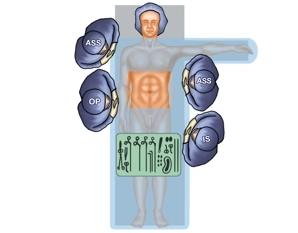The tutorial demonstrates partial gastric resection in cancer of the distal third of the stomach.
Total gastrectomy, which had long been considered the procedure of choice in gastric cancer, does not offer any benefit over R0 resection by partial gastric resection.
When defining the extent of resection, the location of the tumor will be of overriding importance.
- Cancer in the distal third of the stomach → partial (four-fifths) resection
- Cancer in the middle third → gastrectomy
- Cancer in the proximal third with cardiac involvement → extended gastrectomy with transhiatal segmental resection of the distal esophagus
Other indications for total gastrectomy:
- Linitis plastica, a special variant of gastric cancer resulting in diffuse invasion of the gastric wall (mostly signet ring cell carcinoma)
- Cancer affecting several anatomical regions of the stomach (proximal, middle and distal third)
Defining the resection limits has to take into account not only the tumor site but also the histomorphological Laurén classification of gastric cancer:
- Diffuse type of cancer: Proximal margin 5 – 8 cm in situ, i.e., on fresh specimen without traction more than 5 cm
- Intestinal type of cancer: Proximal margin 4 – 5 cm, i.e., 2 – 3 cm on fresh specimen
Thus, in diffuse type of cancer in the distal third of the stomach and in the intestinal type in the middle and distal third of the stomach, partial distal resection usually suffices, while gastrectomy is indicated in all other cases.
Endoscopic resection of early gastric cancer
Superficial early cancer limited to the gastric mucosa (T1aN0M0) can be resected endoscopically because the risk of lymphatic spread is 0 – 2 %. If, on the other hand, the superficial region of the submucosa has already been invaded, the rate of lymph node metastasis jumps to 25 %.
According to the Japanese classification of gastric cancer, endoscopic submucosal resection may be performed in mucosal cancer, if:
- Lesion diameter < 2 cm, elevated type
- Lesion diameter < 1 cm, flat type
- No ulceration
- Histology: Well to moderately differentiated (G1-G2)
The aim is the en-bloc-R0-resection respecting the margins required by the histology of the tumor (intestinal type: 4 – 5 cm, diffuse type: 5 – 8 cm). Patients with helicobacter pylori colonization should be eradicated first.


